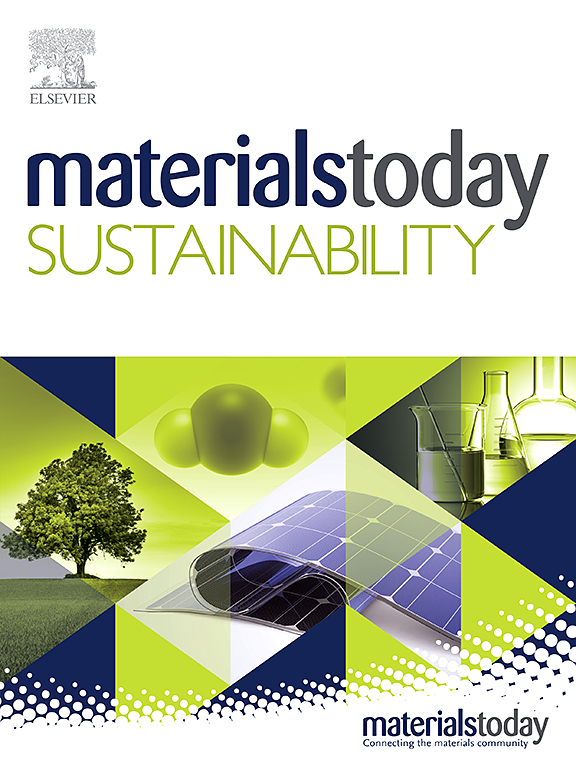Potential application of nano-silica in concrete pavement: A bibliographic analysis and comprehensive review
IF 7.1
3区 材料科学
Q1 GREEN & SUSTAINABLE SCIENCE & TECHNOLOGY
引用次数: 0
Abstract
Rapid population growth in developing countries necessitates high-performance, long-lasting pavement construction. Rigid concrete pavement, commonly used in India, to use for heavy automobile transportation and pedestrian surfaces. However, its high resource consumption, low tensile strength, and initial construction cost are drawbacks. Researchers are exploring the use of nanomaterials in pavement engineering to improve concrete's long-term durability. Nanotechnology is considered the next-generation industrial revolution due to its extraordinary characteristics at a small scale. However, the use of nanomaterials in pavement engineering is still in its early stages. Nanoparticles, which act as fillers and reinforcements in concrete mixtures, enhance the strength and durability of pavements. This is due to the C–S–H gel component of hardened concrete, which is essential for maintaining the pavement's strength and durability. The use of various nanomaterials like nano-silica, nano-CaCO3, nano-Al2O3, nano-TiO2, and nano-clay is being explored as a partial cement replacement. One of the most exciting nanomaterials, nano-silica, is widely used. The study explores the use of nano-silica as a partial replacement for cement, focusing on its impact on mechanical, durability, and microstructure characteristics of concrete pavements. The optimal percentage of nS, as well as the form of nS (powder or colloidal), to improve cement concrete pavement was investigated in this study. The study suggests that nano-silica-modified concrete pavements can withstand vehicles' dynamic and static loads and are a potential eco-friendly alternative to cementitious composites. More percentage of waste materials can be replaced by adding nS to concrete pavement. In comparison to the powdered form of nS, the colloidal form disperses evenly in the concrete matrix without forming agglomerates. According to the study, raising the nS concentration improves mechanical and durability characteristics at 3%, however, above 5% might induce material degradation.
纳米二氧化硅在混凝土路面中的潜在应用:文献分析和综合评述
发展中国家人口的快速增长需要高性能、持久的路面施工。刚性混凝土路面,常用于印度,用于重型汽车运输和行人路面。但其资源消耗大、抗拉强度低、初期施工成本低等缺点。研究人员正在探索在路面工程中使用纳米材料来提高混凝土的长期耐久性。纳米技术被认为是下一代产业革命,因为它在小范围内具有非凡的特性。然而,纳米材料在路面工程中的应用仍处于起步阶段。纳米颗粒作为混凝土混合物中的填料和增强剂,可以提高路面的强度和耐久性。这是由于硬化混凝土中的C-S-H凝胶成分,这对于保持路面的强度和耐久性至关重要。各种纳米材料如纳米二氧化硅、纳米caco3、纳米al2o3、纳米tio2和纳米粘土的使用正在被探索作为部分水泥的替代品。纳米二氧化硅是目前应用最广泛的纳米材料之一。该研究探讨了纳米二氧化硅作为水泥的部分替代品的使用,重点关注其对混凝土路面的机械、耐久性和微观结构特征的影响。本研究探讨了改善水泥混凝土路面的最佳硝态氮含量以及硝态氮的形态(粉末状或胶体状)。该研究表明,纳米硅改性混凝土路面可以承受车辆的动静态载荷,是一种潜在的生态友好型水泥复合材料替代品。在混凝土路面中加入氮化钠可以替代更多比例的废料。与粉末状的nS相比,胶体形式的nS在混凝土基体中分散均匀,不会形成团聚体。研究表明,将nS浓度提高到3%时,可以改善材料的力学性能和耐久性,但超过5%可能会导致材料降解。
本文章由计算机程序翻译,如有差异,请以英文原文为准。
求助全文
约1分钟内获得全文
求助全文
来源期刊

Materials Today Sustainability
Multiple-
CiteScore
5.80
自引率
6.40%
发文量
174
审稿时长
32 days
期刊介绍:
Materials Today Sustainability is a multi-disciplinary journal covering all aspects of sustainability through materials science.
With a rapidly increasing population with growing demands, materials science has emerged as a critical discipline toward protecting of the environment and ensuring the long term survival of future generations.
 求助内容:
求助内容: 应助结果提醒方式:
应助结果提醒方式:


